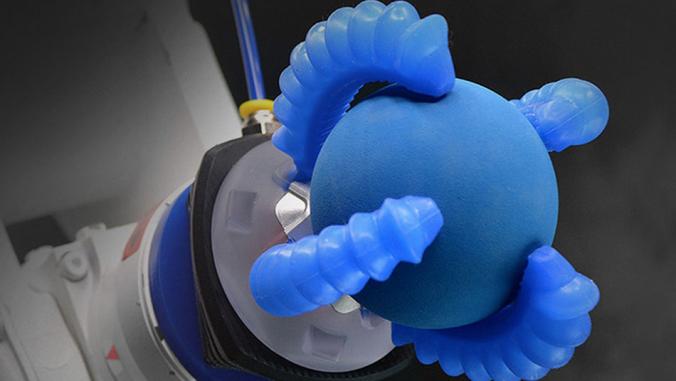Will Synthetic Biology Lead to Truly Living Buildings?
<p>The creation of the world's first artificial life form (a new type of bacteria cell) promises to make synthetic biology a permanent part of our world and the possibility of growing live buildings.</p>

Building image - CC license by Flick user Exothermic
The revolution, it appears, has arrived. We’ve been slow to see it coming. Like the swift lower reaches of a river, its placid public surface has belied the force below.
The recent announcement from Craig Venter that his team at Synthetic Genomics has designed and grown an entirely new type of bacteria cell (the world’s first artificial life form) has changed that. This revolution will now be televised, making synthetic biology a permanent part of our cultural consciousness.
The implications to our society are enormous, and the ethical and practical considerations are myriad. It has made me wonder about our built world and where a synthetic biology trajectory might lead. Will we be able to grow a live building in the future and what relevant forms might result? I think the answer lies in the tracking of several emerging trends. I also believe that any future edifice will, out of necessity, evolve from an interweaving of these trends.
So what appear to me to be the salient trends? Parametric modeling, 3D printing, tissue engineering, nanotechnology, synthetic biology, self-organized manufacturing, artificial intelligence, artificial photosynthesis, swarm robotics, self-replicating machines, self-healing materials, programmable matter, thermodynamics and systems theory. All of these individual fields have great potential in many applications. My interest is in how they might intersect in the world of building, and how that intersection might lead to exponential innovation.
First off, let me be clear about what we are not discussing. We are not talking about training tree branches to grow around themselves into walls, or making bricks out of mushroom mycelia, or using algae to clean up waste. These are all interesting (and worthy) examples of bio-utilization, and may have a role in the development of a grown building, but do not fit my definition of a bio-inspired design. That is one in which biological principles have been translated to manipulate technological methods and materials to solve specific functional problems.
A live building could be the ultimate expression of these bio-inspired design aspirations, but we have a long way to go before a truly biomimetic building is constructed. Statistically, I am sure to be wrong about all these predictions, but perhaps that is besides the point of speculative thinking. Here is my “bio-dream machine,” organized by some important principles.
Nature forms to shape: Growing things make what they need where and when they need it, and in our ideal building that would also be the case. Algorithm-based, or parametric, modeling now allows designers to create organic plans for buildings and to test the stresses that created these shapes. When these powerful tools are employed in the interest of function, strength and durability, the resultant beauty will be truly biomimetic. A good example of this is in Sir Norman Foster’s Great Court roof at the British Museum. In the future, look for buildings to accommodate growth, as well. Designers, there will be no final walk-through. Another way to look at it is that we will be making mechanisms that may perpetuate themselves, not static buildings,. The fourth dimension will be, literally, a growth opportunity and, as in nature, it will be driven by just-in-time information.
Building from the bottom up: 3D printing, tissue engineering and nanotechnology seem poised to jump the fences into other fields, and architecture is one of them. The printing of large objects using the mechanisms used in your inkjet printer has already been demonstrated by Enrico Dini of D-Shape and the techniques for contour crafting a building are being developed by Prof. Behrokh Khoshnevis of the University of Southern California. This technology is scalable and groups like ACASA, incubated at Singularity University, are advocating its use for the developing and disaster-hit regions of the world. It is estimated that such machines, large computer controlled concrete sprayers on gantries, can build a 1,000 square foot house in one day.
In my bio dream machine the laying down or removing of layers of material will become possible during the building’s service, not just during the construction phase. This accretive ability will be integrated into the structure. Informed by a net of sensors, it will add a basic biological characteristic to the building: The ability to maintain homeostasis.
This capacity would not be limited to quantity, but would include selection of characteristics. Frame material, for instance, could be functionally graded for optimal resistance to stress, but it could also be functionally shaped at the material unit level, much like long muscle tissue is different than bone. Even a simple variation of diameter or length of the unit would enable many new design and engineering choices.
Simple components for complex structures: Standardization will take on a new meaning in this brave new world, particularly if the pace of molecular manipulation continues. When the material code for carbon-based molecule production is combined with a reliable delivery system, it is conceivable that builders will be able to dial up the necessary chemical formulas and templates to create any material they would like. By the same token these objects will be easily returned to their base elements to make other needed things. I believe that the manufacturing sector will lead this revolution.
This capacity will also offer an energy saving alternative to intensive, speculative construction by substituting information and time. For example, why not program the building to grow a new module in two years time, using material recycled from the building’s operation and self-organized in a typically slow natural fashion that is unsuitable for traditional building. When you combine the advances in materials learned in tissue engineering and nanotechnology (of which I will write later) it’s not hard to contemplate more “alive” buildings.
Self-organization: Manufacturing is also likely to lead this revolution, driven by cost, and the lessons learned will eventually make their way to the construction industry as well as building maintenance. Aligning components via electrical charge, random mixing of lock-and-key parts and many other techniques now being investigated in labs will have uses in the new paradigm for construction and maintenance. Most of these techniques will take place at a scale well below the macro. Architects and engineers will have to follow, and my advice is to start boning up now.
Surfing for free: Organisms are in a continual evolution to optimize thermodynamic pathways in our physical world, capitalizing on the exergy, or free energy, that is available in gradients. Every time one of our structures gets a free ride on the difference in temperature, moisture, light, heat or electrical charge that exists in its environment, we come out ahead.
Mankind has been pretty clever about this through history, but our tools are more sophisticated now and our need is great. Understanding these elemental forces of nature will be key to any designer looking to innovate. In our bio-dream machine of the future, membranes will open and close, struts will shrink and swell, and lights will shine and dim based on the embedded information in the material and its reaction to an environment that we will have studied, understood and adapted to.
Integration: As I have written before, we combine material things in order to build, but nature integrates them, combining solutions across a hierarchy of scales. Crudely, two things will allow us to truly integrate building technology: A universally adaptable building element as discussed above, and a sufficiently sophisticated information system to control it.
This integration will be a compelling opportunity and it will demand a knowledge of how systems operate, particularly information systems as they are exhibited in nature. We are experiencing an ongoing revolution in building information systems, but it seems to me that our current conception of sequential feedback loops and layered, separate systems will probably change with the development of memristors, neurological research and information net theory as they affect our capacity in artificial intelligence.
In summary, whatever the eventual form my bio-dream machine takes, it will have the following attributes:
- Its form will follow function and chemical and physical forces through a hierarchy of scales.
- Its complex structure will be built from relatively few basic components. All the component parts will be modified, disassembled and aggregated in numerous ways.
- Special structures will have special functions, and that will be reflected down to the material unit level. The structure will be built from the bottom up using recipes, not blueprints.
- The building will have the ability to adapt to external conditions, either from preprogrammed information or from response mechanisms. It will, therefore, have the ability to efficiently maintain its own homeostasis, in other words, the maintenance of stable internal conditions in response to external conditions.
- This homeostasis will be achieved either by conforming to conditions (surfing for free) or regulating them (information driven feedback networks). Material and energy will flow through this open system and be integrated into a larger network of other buildings and infrastructure. Both material and energy will be processed by either preprogrammed information or real-time control mechanisms.
- That processing will be carried out by highly specific, but adaptable, substructures that have been formed from basic component parts and are integrated across scales by a sophisticated information control system.
I have just described, as any biology major reading this will recognize, my pet cat Rosie, or any other living organism, for that matter, and that is exactly my point. The amazing bit is that technology is building the capacity to achieve some of these wondrous capacities. Designers have only to look beyond their desks.
Tom McKeag teaches bio-inspired design at the California College of the Arts and University of California, Berkeley. He is the founder and president of BioDreamMachine, a nonprofit educational institute that brings bio-inspired design and science education to K12 schools.
Building image - CC license by Flick user Exothermic





